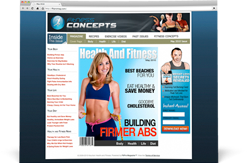Selling Personal Training Online, Part 2 – Creating and Marketing Your Program
Posted by Steve Hochman on Tue. Oct. 28th, 2014
In my last blog post, I explained how selling personal training through an online program can bring you long term passive income as well as new clients for your fitness boot camp business. To recap what I explained in the last post, there are several benefits to offering personal training through an online coaching program:
- Immediate income generated through sales.
- Long-term income potential through building trust and credibility.
- Passive income from your program with no significant work needed from you.
- Potential new client income through program’s visibility on Facebook and other social media.
- Potential new long-term clients by converting online members to boot camp members.
But first you need to decide what type of program you’re going to create and then how to set up the marketing and delivery for that program. Fortunately, Shawna Kaminski, the FBBC owner who earned $7,000 in 72 hours with her online coaching program, was kind enough to offer up a blueprint for both.
Creating Your Online Coaching Program
 Selling personal training through an online coaching program isn’t that much different from coaching clients in your boot camp. Think about what you provide your clients in your boot camp in order to get them the results they need: nutritional guidance, a great workout, accountability, motivation and support from both you and fellow clients. These are the things that need to be included in your online coaching program. You can even create a partnership with a local nutritionist. They can create the nutrition plan, you create the workouts and both of you market to each other’s mailing lists.
Selling personal training through an online coaching program isn’t that much different from coaching clients in your boot camp. Think about what you provide your clients in your boot camp in order to get them the results they need: nutritional guidance, a great workout, accountability, motivation and support from both you and fellow clients. These are the things that need to be included in your online coaching program. You can even create a partnership with a local nutritionist. They can create the nutrition plan, you create the workouts and both of you market to each other’s mailing lists.
The type of nutritional plan and workout that you create for the program will depend on your expertise, your group’s goal and their demographic. It will depend on whether you’re doing a fat-burning program, a strength building program, a special abs program and so on. You could also skip the specialization altogether and make your selling point the fact that people who aren’t ready/comfortable with/into a group training environment can get all of the benefits of your boot camp right in their own home.
Prior to creating her online coaching program, Shawna polled her mailing list and got their basic information and also asked them what their specific fitness issues and obstacles were. Then she took that information and created a program that would meet the needs of the most people.
Structuring Your Online Coaching Program
It’s important to keep things as simple and consistent as possible, especially your first time around. Shawna set up a 90 day coaching plan, which she priced at $99/month, paid up front at $297. She changed up the workouts every few weeks and a created a scalable nutrition plan. She met with her coaching clients daily in a private group on Facebook to provide that accountability, motivation and support that people need to succeed.
Shawna also set up auto-responders to let people know when they were accepted to the program, to welcome them to the program and lead them to the download page for the nutritional plan and workout modules and also to get the link to the special Facebook page. Each of these emails only takes a few minutes to create and programs like MailChimp make the process simple and quick.
Marketing Your Online Coaching Program
Once you have your program designed, you need to market it. Your market is your mailing list of prospects, but you can also post about your online program on your Facebook page and ask current clients to share or even tag your current clients and tell them their friends might be interested.
 Your mailing list is going to give you your best return, though and you need to market to those prospects for a couple of weeks before actually making sign-ups available. One email may keep it short and sweet with a teaser about your exclusive new online coaching program. The next week, let them know the details; what the program entails and the dates.
Your mailing list is going to give you your best return, though and you need to market to those prospects for a couple of weeks before actually making sign-ups available. One email may keep it short and sweet with a teaser about your exclusive new online coaching program. The next week, let them know the details; what the program entails and the dates.
This approach builds interest in the program and creates both excitement and a perception of exclusivity. You’re going to build on that perception by making the program exclusively to those who apply for it and are deemed a good fit.
This application process not only promotes that sense of exclusivity, it also weeds out tire kickers, the uncommitted and people who will likely flake after the first week.
You can see Shawna’s application here to see how she used Google Docs to create and accept applications in less than ten minutes.
Running Your Online Coaching Program
Once you have your coaching group, delivery of the different modules and any weekly emails you might want to include can be set up to run automatically. All you really need to do is post daily to your Facebook page. You’ll be posting motivational comments, responding to the individual group members as they post their daily progress reports and encouraging clients to interact with each other. This is also a great way for you to monitor the effectiveness of your program and identify any changes or additions you may need to make.
The beautiful thing is that once you’ve created this 90-day program, you never have to re-create it. You can offer it continuously and reuse the same models and the same emails over and over for newcomers. At the same time, you can create intermediate and advanced programs to offer those who have nearly completed their first 90 days, if that’s something you choose to do. Within a year, you can create a year’s worth of online coaching programs that you can sell the next year and the next and the next.
The most successful FBBC owners are always trying new things, offering their clients more value and finding new ways to help more people. Online coaching is an excellent way to supplement and grow your business, build your client list and help cement your reputation as a local fitness expert.
It’s a win-win for everyone and the potential ROI is enormous.
Posted in Fitness Information Product, Fitness Marketing, Internet Marketing, Selling Personal Training by |

